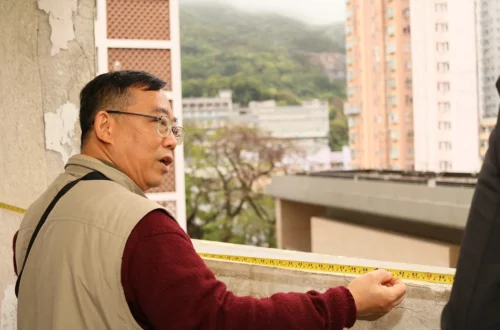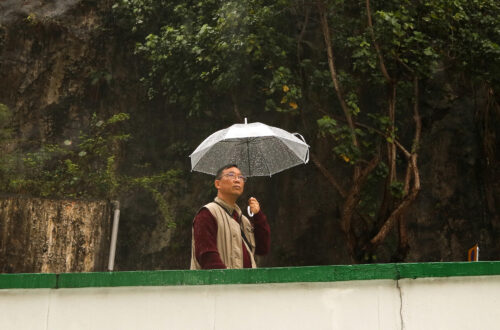Studying from the Comfort of Balcony with Mountain and Sea Views
Studying from the Comfort of Balcony
with Mountain and Sea Views
Lai Wai Chung / One of the first residents of Ming Wah Dai Ha

Professor Lai moved out of Ming Wah Dai Ha on a rainy day much like today, 40 years ago.
“What’s the length here?” “Hey, pull the tape taut.” Lai Wai Chung, Professor of the Department of Real Estate and Construction at the University of Hong Kong, revisited the apartment in which he had resided for over a decade. A fellow architect and a student accompanying him wasted no time in pulling out their tape measures and recorded the dimensions of Flat 307 Block G, a place full of Lai’s memories from his childhood until his university graduation. While redrawing the plans for the flat, Lai reminisced about his time studying from the comfort of a balcony with breath-taking mountain and sea views at Ming Wah.
Understanding tenants' needs through home visits
Before moving into Ming Wah, Professor Lai lived in a “Tong Lau” (tenement building) in Wan Chai where he had to share the living space, kitchen and bathroom with over 20 occupants. Lai’s father was a civil servant who walked to work in Central. When Lai’s two younger siblings were born, it became apparent that the apartment was far too small for a family of seven. His father thus submitted an
application to move to the newly completed Ming Wah Dai Ha. In 1963, they moved to Ming Wah for a new start. Lai recalled that a female housing affairs assistant would come visit their flat every month on the rent due day. In addition to rent collection, the assistant would chat with the tenants and their kids to get to know more about their lives, and also to see if the tenants might have made any alterations to the flat or if there were any changes in household particulars. His mother would always treat these visits seriously, worrying that her children would say something embarrassing.
“We called them ‘Gu Neong’. Some of these assistants were Chinese and some were foreigners. They showed great care about the tenants. Once the Gu Neong noticed that the floor was uneven in our unit, she quickly asked someone to fix it for fear that we might trip over and get hurt.” Now looking back as an adult, Lai realised that such work ethic and genuine care for the tenants’ well being is hard to come by.
Open and spacious layout
In the 60s and the 70s, a lot of primary and secondary school students worked after school to help support their families. Professor Lai was somewhat lucky. As a child, he never had to worry about making ends meet. However, in the old days, not every family could afford to buy a television set. Like every other kid at the time, he would gather with other kids outside a neighbour’s home to watch cartoons on TV. Sometimes a crowd of up to 10 may appear.
To prepare for the public exams, Lai spent more time studying than watching TV after school when he was a Form 5 student. He turned the balcony into his private study with a folding table and a wooden stool and could easily spend half a day there with his textbooks. While sitting on the balcony, Lai was deeply impressed by the beautiful scenery outside. With no high-rise buildings nearby, Lai could enjoy an unobstructed view as far as Kowloon and Kai Tak Airport on the far side of the harbour. At that time, the hills and the sea were not too far away. The Shau Kei Wan bus terminus was sited on a mudflat where the elevated stilt houses of fishermen were located. In the summer, kites filled the sky. A game called “kite snatching” was popular among kids at the time. Children would try to snatch kites using strings or long forks. If you could grab hold of a kite, it’s yours. You may think kids would fear retribution, but Lai quickly explained, “It’s just one of those unspoken rules at the time.” Child innocence could be seen on Lai’s solemn face as he vividly reminisced about his childhood mischief.
“It’s not even 400 square feet?” The professor was stunned as his student reported his measurements of the flat. “It felt like at least 800 square feet to me.” Though currently residing in a 700 square feet apartment, Lai had always thought that his old home in Ming Wah was larger. “Maybe because we had a balcony protruding from the building, it made the space feel a lot more open.” That “openness” refers not only to the views, but also the relationship between neighbours. Residents did not mind sharing their TV sets, or having their kites snatched away, or even being disturbed while studying. “Women would gather and chat, people would play mahjong. Sometimes a neighbour would practise the trumpet or listen to music on hi-fi, but residents seldom complained.”
“I’d happily take this flat back if the owner wants to sell it.”
A town planning specialist, Professor Lai believes that doing away with gates was one of the design merits of Hong Kong’s older public housing estates. People could come and go freely. “We didn’t need to be isolated as if living in barracks. Ming Wah opened its doors to everyone and we never had people coming to cause us trouble.”Lai questions the wisdom of the current trend of siting a housing estate near shopping malls and supermarkets:“Wouldn’t it be better if we reserve more space for kids to play in?”Lai has fond memories of a good time on the playground and at the library. Redevelopment will soon begin however, as the city landscape is undergoing transformation and Hong Kong’s natural coastline slowly disappearing under reclamation. Though it has been years since moving out, Lai still remembers the good old days he had spent here at Ming Wah. “I’d happily take this flat back if the owner wants to sell it.”

Lai Wai Chung moved out of Ming Wah Dai Ha in 1982 and recently revisited his old home.

While all iron gates may look alike to people outside Ming Wah, Professor Lai can easily relate each flat to the family living in it. He can tell you interesting titbits like the family whose daughter is a doctor and the family that hails from Zhongshan. His next door neighbour in Ming Wah now lives in the same building as Professor Lai.

Professor Lai remembers that the wooden cabinets in the kitchen used to be white, and he often grabbed red dates as a snack.

After the Lai family moved out, another family moved in and redecorated the unit in a very different style. However, Professor Lai still recognises the iron gate leading to the arcade.

Opposite the terrace is the tram terminus and the market. Professor Lai remembers that the coastline was not far from the market then.
Connection to Ming Wah Dai Ha: Lived in Ming Wah between 1963 and 1982; revisiting his old home for the first time in 40 years
細説明華
Ming Wah Dai Ha
Documentary Project
Copyright|Disclaimer | Contact us
Organiser|Hong Kong Housing Society
Collaborator|Dragon Foundation、Lion Head Culture、Hide and Seek Tour
Copyright © 2024 Hong Kong Housing Society. All Rights Reserved.
細説明華
Ming Wah Dai Ha
Documentary Project
Copyright|Disclaimer | Contact us
Organiser|Hong Kong Housing Society
Collaborator|Dragon Foundation、Lion Head Culture、Hide and Seek Tour
Copyright © 2024 Hong Kong Housing Society. All Rights Reserved.